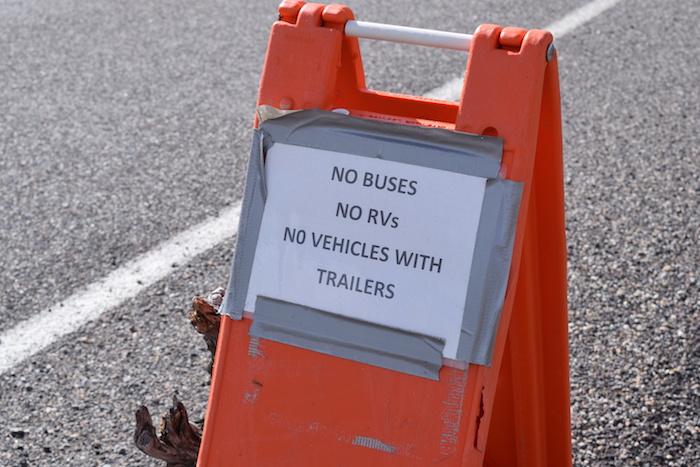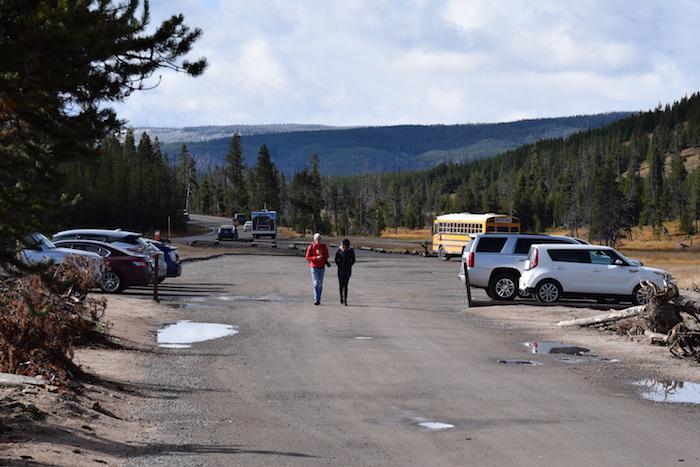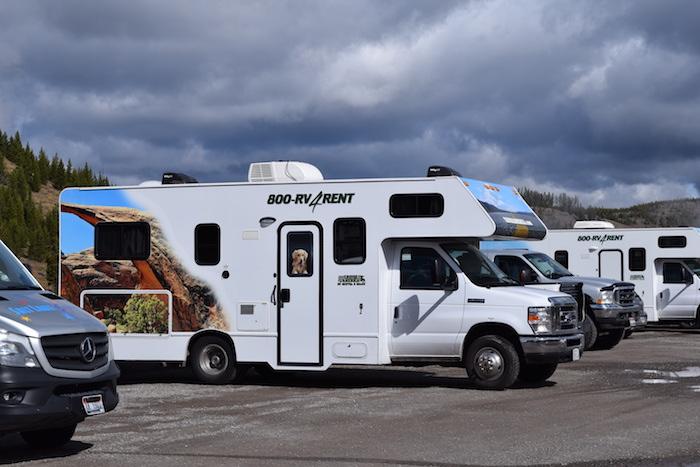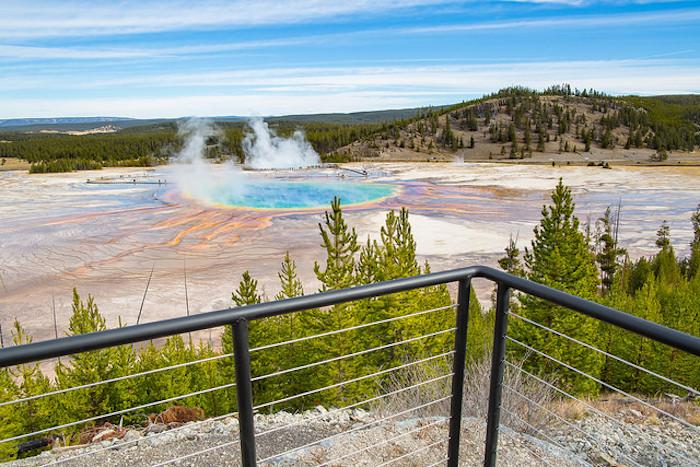When Yellowstone National Park officials added a parking area near Grand Prismatic Spring in the Midway Geyser Basin, they intended for it to be for passenger vehicles, not buses or RVs. Unfortunately, it appears the park lacks the staff to police those requirements, and motorists seem to lack an ability to read signs.
The accompanying photos were taken earlier this month at the gravel lot park crews gouged out of a meadow near the Fairy Falls Trailhead. The three-quarters-of-an-acre lot was deemed necessary because when the existing parking lot at Grand Prismatic Spring fills up, visitors park on the roads. However, the lot is not connected to the Grand Prismatic trail system by a foot path, so visitors who use it have to walk along the road if they want to view that colorful hot spring up close.
The new lot, which park officials said was being tried on a temporary basis, is located on land once traversed by an old stage road. Whether RVs and buses also park there during the height of the summer season could very likely depend on whether an attendant is there to monitor traffic.




Whether the parking area is ever erased, or paved over, remains to be seen. But park crews have created a new trail that leads to a hardened overlook of Grand Prismatic Spring.

This hardened overlook was created at the same time Yellowstone crews established a new parking area near the Fairy Falls Trailhead/NPS, Neal Herbert

This aerial photo shows were the new parking area was created in relation to Grand Prismatic Spring, and the section of road visitors would have to walk along to reach the spring from this lot/NPS



Comments
This 2015 summary lists over twenty million dollars in deferred trail maintenance and almost ten million dollars in deferred unpaved road maintenance at Yellowstone:
https://www.nps.gov/subjects/plandesignconstruct/upload/FY-2015-NPS-Asse...
No matter how desirable, or even necessary, new developments such as this parking area and overlook trail may be, diverting staff from existing maintenance to add assets to the long-term maintenance inventory is not a sustainable management strategy. In fact, this practice, ongoing for decades, has been a large factor increasing the national deferred maintenance backlog.
we visited Yellowstone about 3 years ago, and had an amazing time, but were stunned at how many people just didn't bother with posted signs... especially re:parking and getting close to animals. sad, really that people choose to do what they want, rather than what is best to preserve the treasures there.
First off, the trailhead parking was not built to support visitors attempting to access the Grand Prismatic Spring/Midway Geyser Basin boardwalk, it was to support the large number of people walking the Fountain Freight Road/Fairy Falls trail, which now includes a very nice overlook of the Grand Prismatic feature as seen above. And that overlook was built to try to assuage the massive number of people wanting to see the feature from above and who were determined to do so regardless of closure signs and steep slopes and leaning snags from the '88 fires...and pounding the hell out of the hillside resulting in significant resource impacts and safety concerns including a fatality not too long ago, I believe.
I get it, and I somewhat agree with Tahoma's point, but you can't stay still especially when large swings in visitation occur. So no, the park didn't build it so they'd come. More like: if they come, they have to build it.
By the way...commuting past that parking lot weekly during the summer months once it opened, seldom did I see an oversized vehicle parked there. Here and there a car was parked where the pavement was marked no parking to preserve space for turning, but I and many other employees were very pleasantly surprised how well the parking managed itself during the busiest weeks. Now that things are slower, human nature is taking over, sure.
We visited the park over the 4 th of July this year. We left our 5th wheel trailer at the campground outside the park. Even with doing this we had trouble finding parking for our 4 door truck not only here but in most lots through the park. I would never think of trying to bring a RV into the park. People have to use common sense.
This complaint goes both ways. RVs get very few parking opportunities and while it is posted as such cars park in those spots designated for RVs and trailers all the time with no enforcement. Parking should be opportunistic and as long as there is space and some order then anyone should be able to park. RVs could easily park around the perimeter of most lots if space was allotted. Also most of the "RVs" in your photo can fit into standard parking that a extended bed full size truck would, so do they really fit the Mark for your complaint? I think not.
Turn about is fair play! We visit the parks with a small travel trailer in tow. We usually unhitch and leave the trailer at the campground but occasionally we want to stop and see something on our way from one campground to the next. I can't count the number of times we have not been able to park the car and trailer because the RV parking spots have been taken up by passenger cars. I don't see anyone writing stories about cars taking up RV parking spaces!
You're absolutely right, Jennifer, it can happen. But what do you do if that car has an 18-foot-7-inch canoe on the roof and a trailer in tow?
Seriously, you raise a fair question. Which goes back to a lack of parking in parks such as Yellowstone. But what's the solution? Building more parking lots, or limiting vehicles, either by shuttle systems or reservations for those who wish to enter a park?